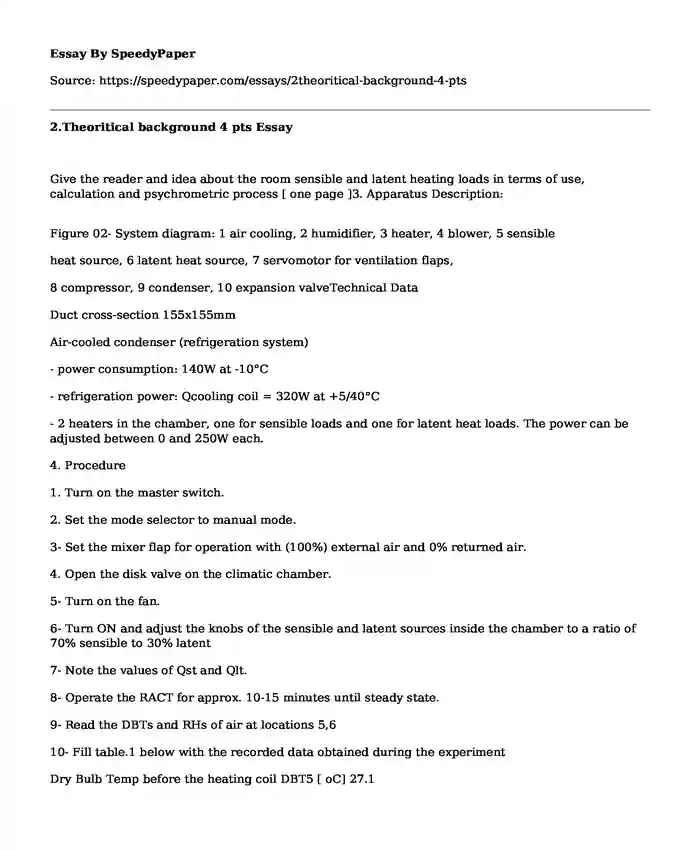Give the reader and idea about the room sensible and latent heating loads in terms of use, calculation and psychrometric process [ one page ]3. Apparatus Description:
Figure 02- System diagram: 1 air cooling, 2 humidifier, 3 heater, 4 blower, 5 sensible
heat source, 6 latent heat source, 7 servomotor for ventilation flaps,
8 compressor, 9 condenser, 10 expansion valveTechnical Data
Duct cross-section 155x155mm
Air-cooled condenser (refrigeration system)
- power consumption: 140W at -10C
- refrigeration power: Qcooling coil = 320W at +5/40C
- 2 heaters in the chamber, one for sensible loads and one for latent heat loads. The power can be adjusted between 0 and 250W each.
4. Procedure
1. Turn on the master switch.
2. Set the mode selector to manual mode.
3- Set the mixer flap for operation with (100%) external air and 0% returned air.
4. Open the disk valve on the climatic chamber.
5- Turn on the fan.
6- Turn ON and adjust the knobs of the sensible and latent sources inside the chamber to a ratio of 70% sensible to 30% latent
7- Note the values of Qst and Qlt.
8- Operate the RACT for approx. 10-15 minutes until steady state.
9- Read the DBTs and RHs of air at locations 5,6
10- Fill table.1 below with the recorded data obtained during the experiment
Dry Bulb Temp before the heating coil DBT5 [ oC] 27.1
Relative Humidity after the heating coil RH5 [%] 75.5
Dry Bulb Temp after the Heater DBT6 [ oC] 30.1
Relative Humidity after the Heater RH 6 [%] 62.7
The air velocity in the duct system V [m/s] 0.57
Sensible heat rate Qst [kW] 0.225
Laten heat rate Qlt [kW] 0.097
Table . 1 Experimental results5- Questions:
1- Represent the process on the psychrometric chart. 2 pts
2. Fill table.2 using the data recorded and the psychrometric chart, 2 pts
3. Calculate the mass flow rate of air ma 2 pts
4- Calculate the following
a- the sensible heating rate Qs in kW. 2 pts
b- The latent heating rate in Ql kW 2 kW
5- Discuss your results in terms of the difference between the theoretical (Qst, Qlt) and calculated values (Qs, Ql) of the sensible and latent heat rate. 4 pts
6- conclusion 1 pt
Total ....../15
-1600200
Enthalpy before the heating coil h5 [kJ/kg] 70.2
Enthalpy after the heating coil h6 [kJ/kg] 73.2
Specific volume v5 [m3/kg] 0.873
Calculation
From chart
Hw= 69 KJ/KG
3) ma = ( Area x Velocity)/ specific velocity
= (0.155 x 0.155 x 0.57)/ 0.873
= 0.0157 Kg/s
4) Qs= ma (H6-Hw)
= 0.0157(73.2-69)x 1000
= 65.94 W change into kW
1W= 0.001 kW
65.94W
=0.06594kW
Ql= ma (H5-Hw)
= 0.0157(70.2-69)x1000
= 18.84 W change into kW
1W= 0.001kW
18.84W
=0.01884kW
Discussion
The results showed that the calculated latent heat rate value of the experiment was 0.01884kW while the theoretical value was 0.097kW. It illustrated that there was a slight energy difference between the practical and theoretical models. The study indicated that the calculated sensible heat rate value was 0.06594kW while the theoretic figure was 0.225kW. It showed that the practical load needed a small amount of energy to change in temperature than the theoretic equipment.
Conclusion
The experiment focused on analyzing the difference between theoretical and calculated sensible and latent heat rates. Latent heat is the energy absorbed or emitted from a substance causing change in the state of matter. It is important to note that the process takes places under constant temperature. Latent heat rate is the quantity of energy required to change the state of 1 kg of a substance. Latent heat deviation is the term given to the difference between calculated and theoretical latent heat values. From the results, the latent heat deviation was 0.078kW. The latent heat load required less energy to change to another state of matter than the theoretic load.
Sensible heat is the energy needed to cause a change in the temperature of an object without changing it to another state of matter. Sensible heat rate is the amount of heat required to cause a temperature change in a 1 kg of a substance without changing its state of matter. Sensible heat rate deviation is the difference between the theoretical and calculated sensible heat rate figures. The study illustrated that the experiment's sensible heat rate deviation was 0.159kW. There are differences between calculated and theoretical heat rate values because there is presence of errors during an actual experiment. Experts derive theoretical values using constant values which change in practical work.
Cite this page
2.Theoritical background 4 pts. (2023, Jan 10). Retrieved from https://speedypaper.com/essays/2theoritical-background-4-pts
Request Removal
If you are the original author of this essay and no longer wish to have it published on the SpeedyPaper website, please click below to request its removal:
- Theology Essay Sample
- Free Essay Example on Customer Satisfaction
- Free Essay with a Formal Analysis of The Three Graces and Vamping on Cumberland by Sally Mann
- Free Essay Example on the Men's Fashion Industry
- Free Essay Sample: Passive Investment Strategy in The Stocks Market
- Essay Sample Dedicated to Mental Health Policy in Namibia
- Essay Sample on Marcus Garvey's Dealings and Accomplishments
Popular categories





